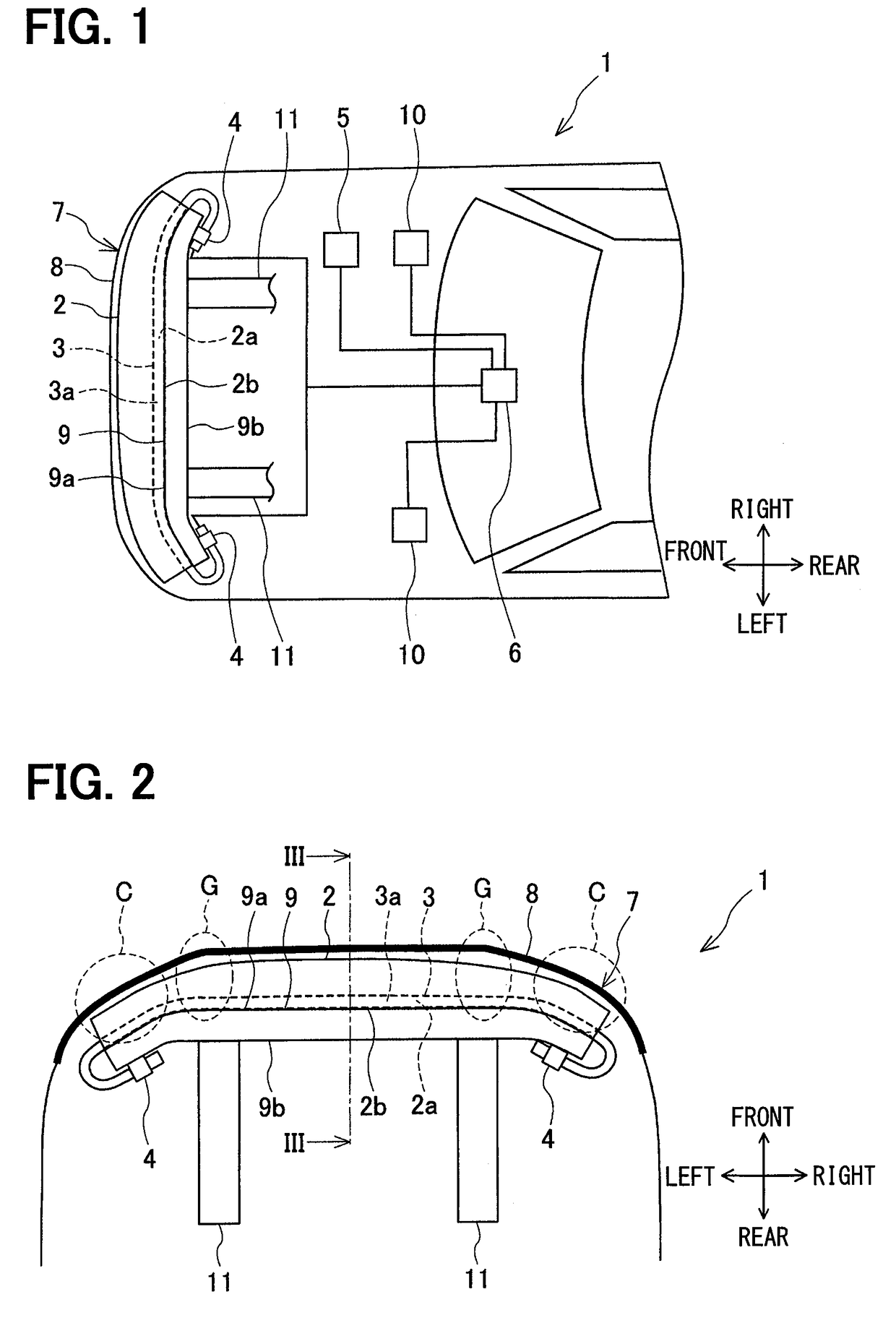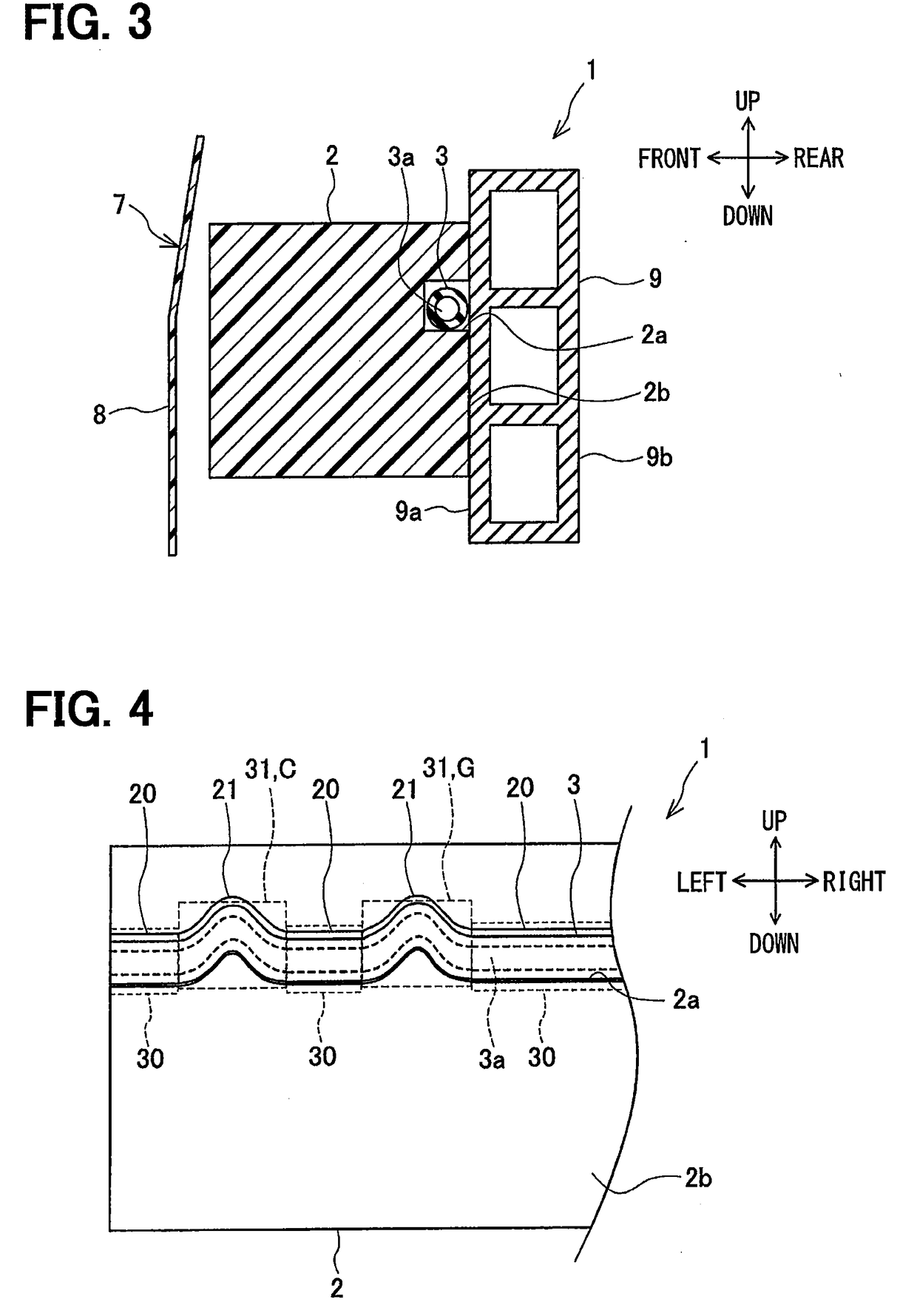Collision detection device for vehicle
a detection device and vehicle technology, applied in vehicle components, pedestrian/occupant safety arrangements, bumpers, etc., can solve the problems of tube components that cannot be fully deformed at a time, and the output of pressure sensors may become small, so as to achieve high accuracy
- Summary
- Abstract
- Description
- Claims
- Application Information
AI Technical Summary
Benefits of technology
Problems solved by technology
Method used
Image
Examples
first embodiment
[0022]A collision detection device for a vehicle according to a first embodiment is explained with reference to FIG. 1 to FIG. 7. As shown in FIG. 1 and FIG. 2, the collision detection device 1 of this embodiment includes a bumper absorber 2, a hollow detection tube component 3, a pressure sensor 4, a speed sensor 5, and a collision detection ECU 6. The collision detection device 1 detects a collision of an object (such as pedestrian) to a bumper 7 disposed at the front of the vehicle. As shown in FIG. 3, the bumper 7 mainly includes a bumper cover 8 and a bumper reinforcement 9 in addition to the bumper absorber 2.
[0023]The bumper absorber 2 absorbs impact in the bumper 7, and is made of, for example, polypropylene foam. As shown in FIG. 3, the bumper absorber 2 is disposed at a position opposing a front surface 9a of the bumper reinforcement 9, e.g., on the front of the vehicle, and extends in the vehicle width direction. Although not illustrated, the bumper absorber 2 and the bum...
second embodiment
[0061]A second embodiment is described with reference to FIG. 8. In FIG. 8, the same mark is given to the same portion as the first embodiment to omit the explanation, and only a different portion is explained. In the second embodiment, as shown in FIG. 8, the detection tube component 3 is mounted in the groove portion 2a in the state where a cove curve portion 32 of the detection tube component 3 is curved to the lower side relative to the horizontal portion 30. The groove portion 2a has the horizontal groove portion 20 extending in the vehicle horizontal direction, and the curve groove portion 22 curved to the lower side relative to the horizontal groove portion 20.
[0062]Similarly to the first embodiment, the curve groove portion 22 is defined at totally four places, e.g., two of the high rigidity parts G right and left where the rigidity of the front grille is high and two of the corner parts C right and left of the bumper cover 8, and is formed to be curved to the lower side rel...
third embodiment
[0065]A third embodiment is described with reference to FIG. 9. In FIG. 9, the same mark is given to the same portion as the first embodiment to omit the explanation, and only a different portion is explained. In the third embodiment, as shown in FIG. 9, the groove portion 2a has the horizontal groove portion 20 extending in the vehicle horizontal direction, and a curve groove portion 23 curved to the upper side and the lower side relative to the horizontal groove portion 20 to have wave shape. The detection tube component 3 is mounted in the groove portion 2a in a state where the detection tube component 3 has the horizontal portion 30 extending in the vehicle horizontal direction and the cove curve portion 33 curved to the upper side and the lower side relative to the horizontal portion 30.
[0066]Specifically, the curve groove portion 23 is formed to be curved in the wave shape from the corner part C adjacent to the end in the vehicle width direction to the high rigidity part G whe...
PUM
 Login to View More
Login to View More Abstract
Description
Claims
Application Information
 Login to View More
Login to View More - R&D
- Intellectual Property
- Life Sciences
- Materials
- Tech Scout
- Unparalleled Data Quality
- Higher Quality Content
- 60% Fewer Hallucinations
Browse by: Latest US Patents, China's latest patents, Technical Efficacy Thesaurus, Application Domain, Technology Topic, Popular Technical Reports.
© 2025 PatSnap. All rights reserved.Legal|Privacy policy|Modern Slavery Act Transparency Statement|Sitemap|About US| Contact US: help@patsnap.com



